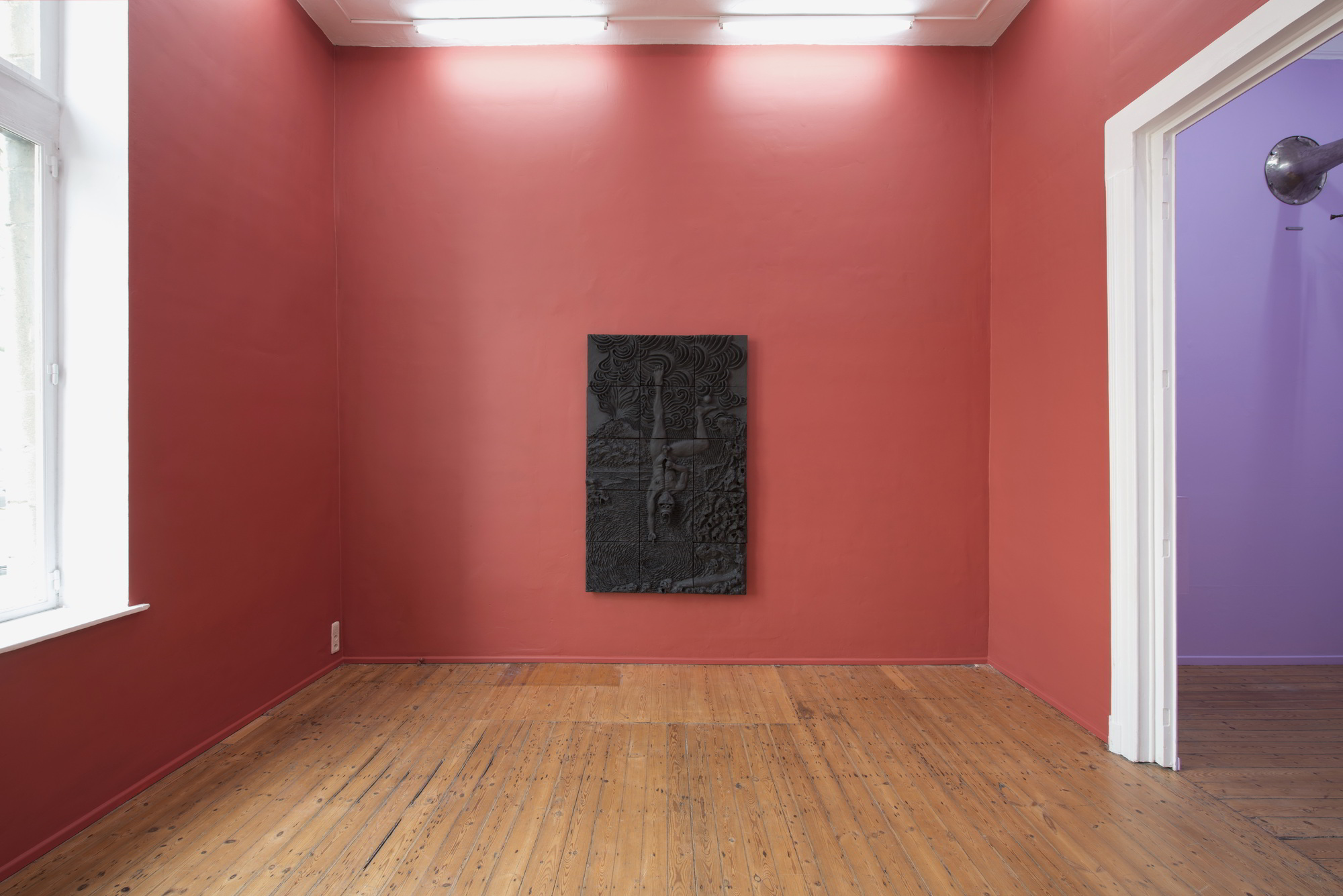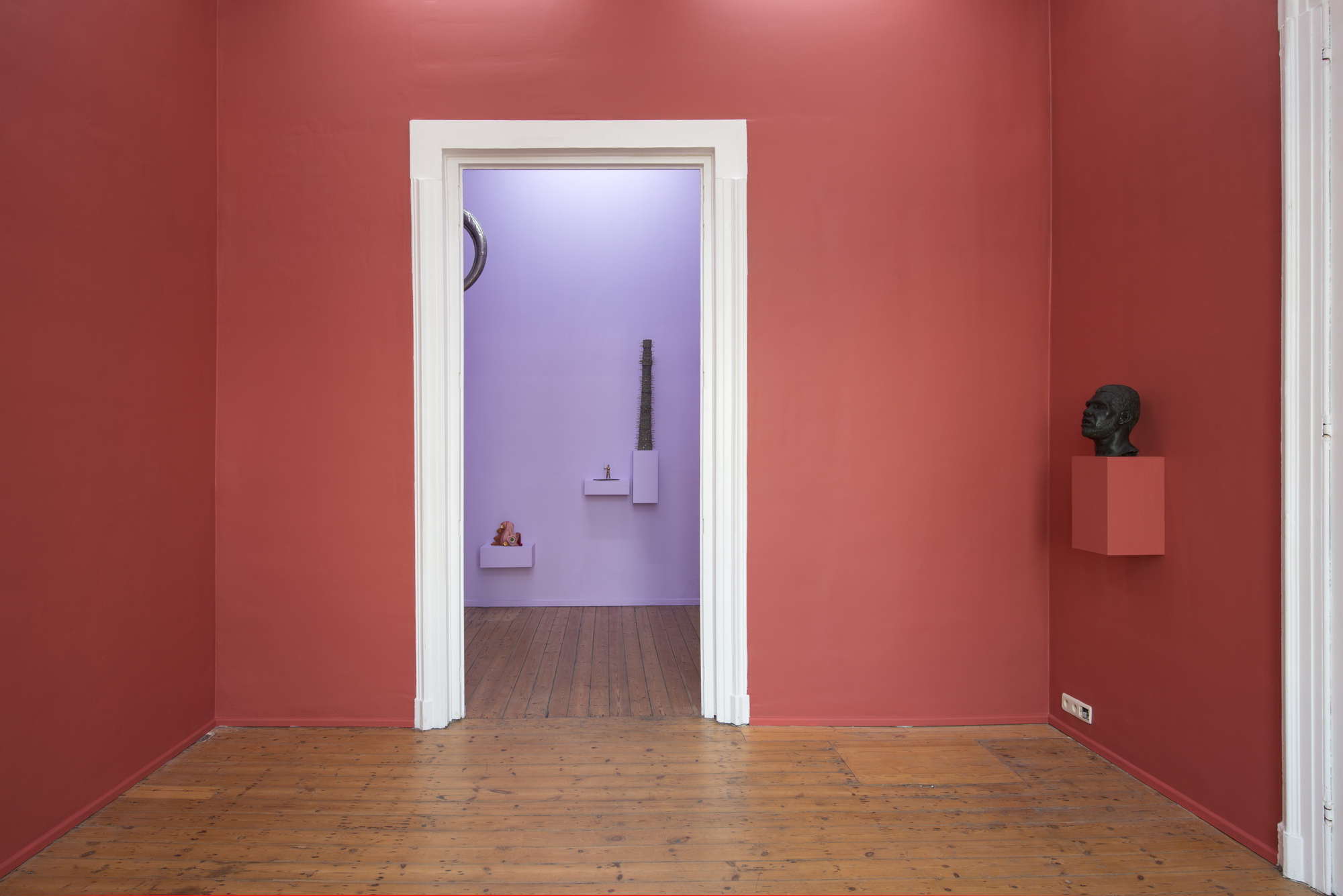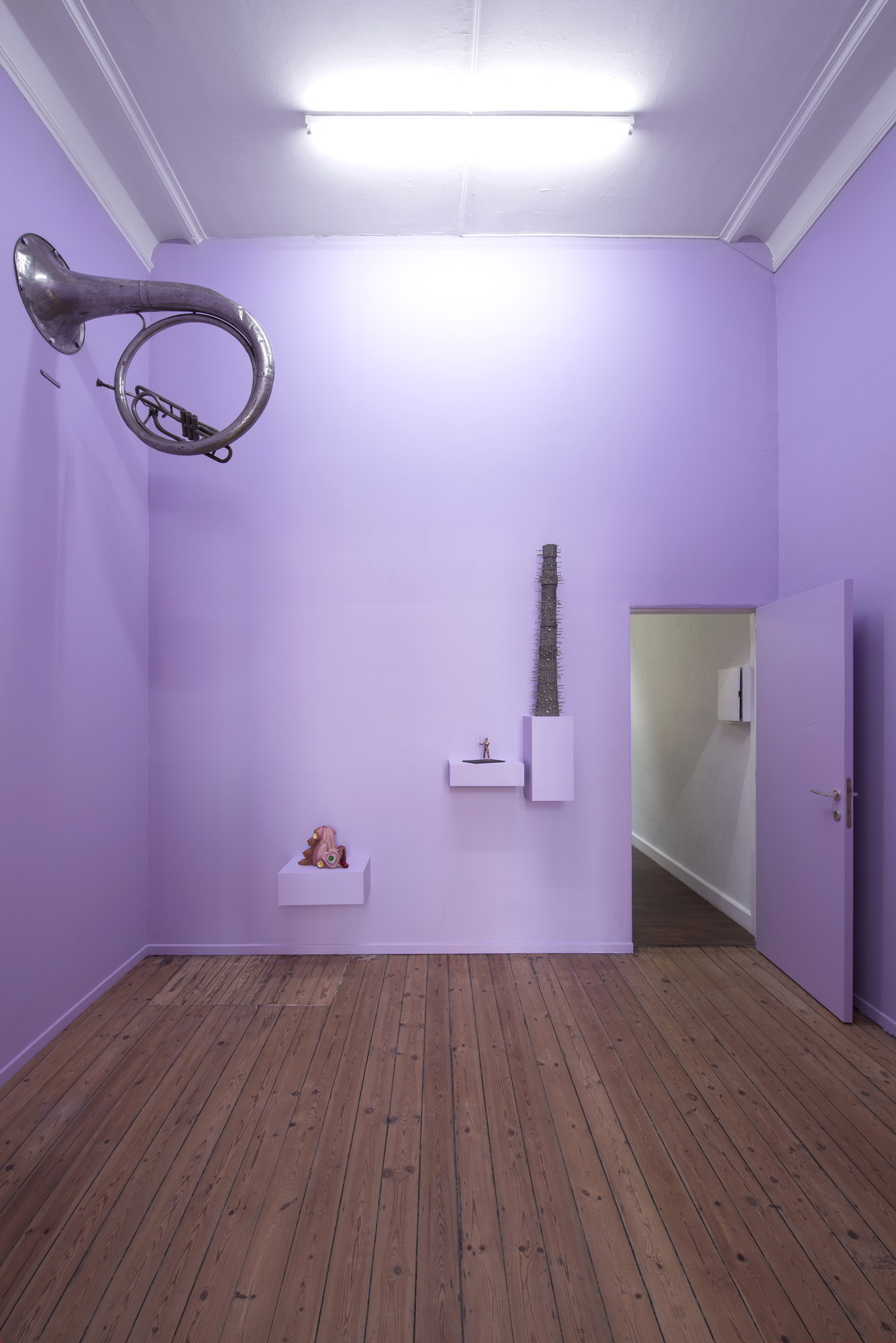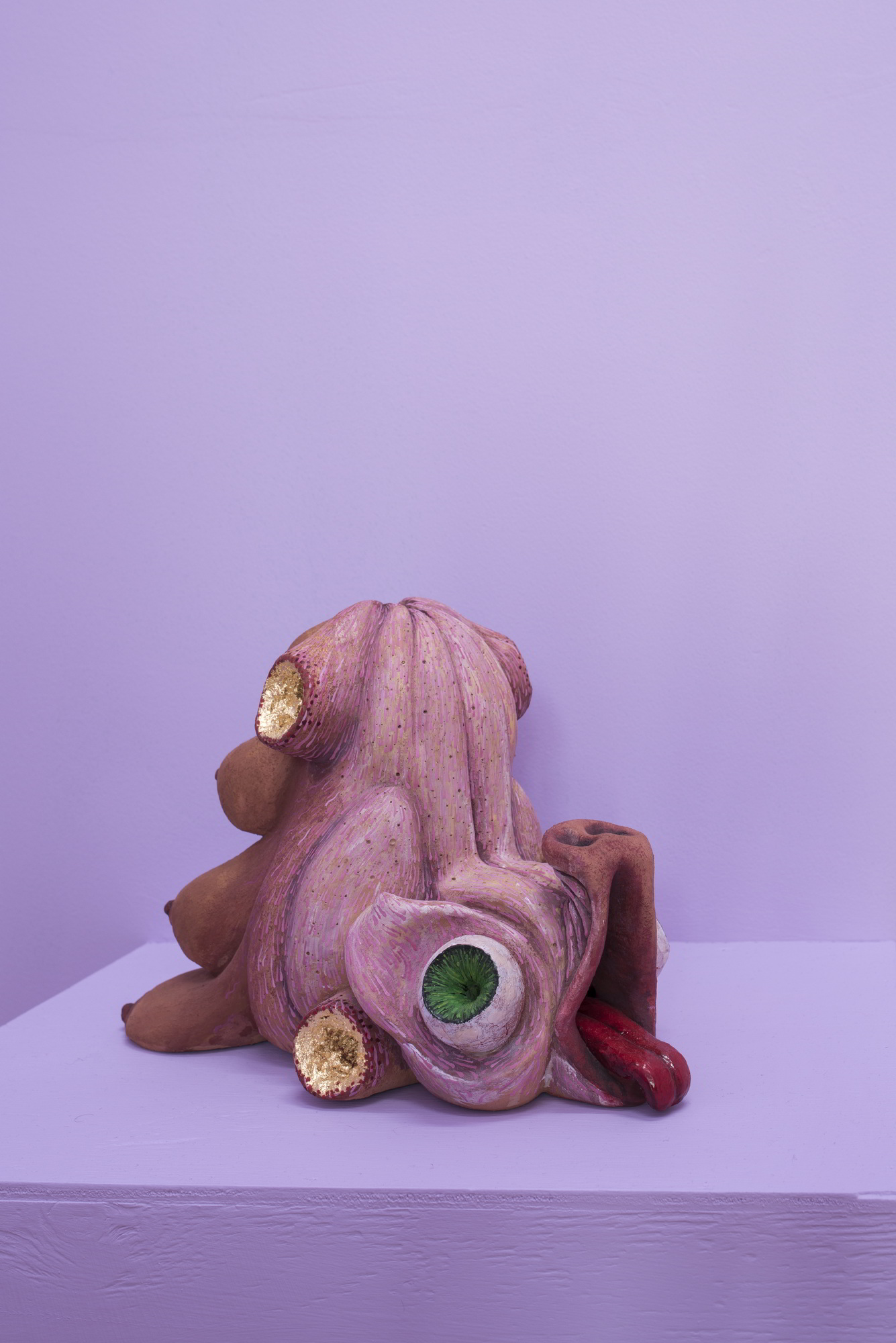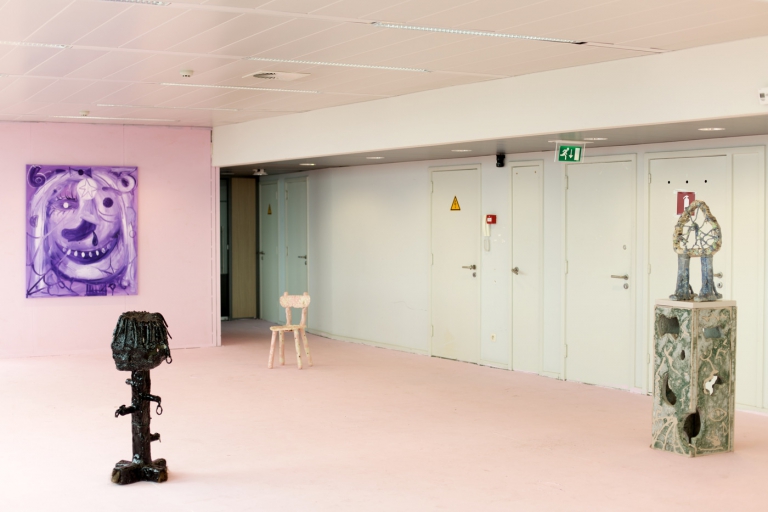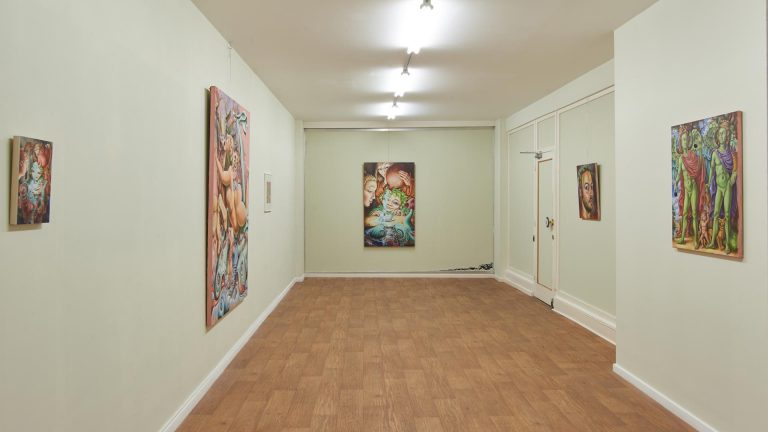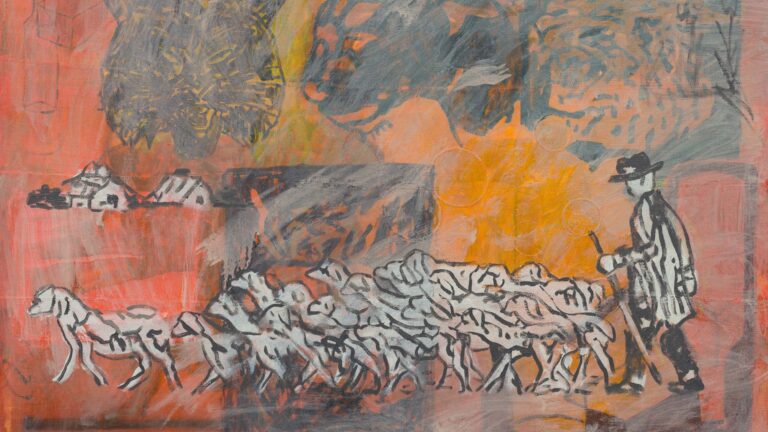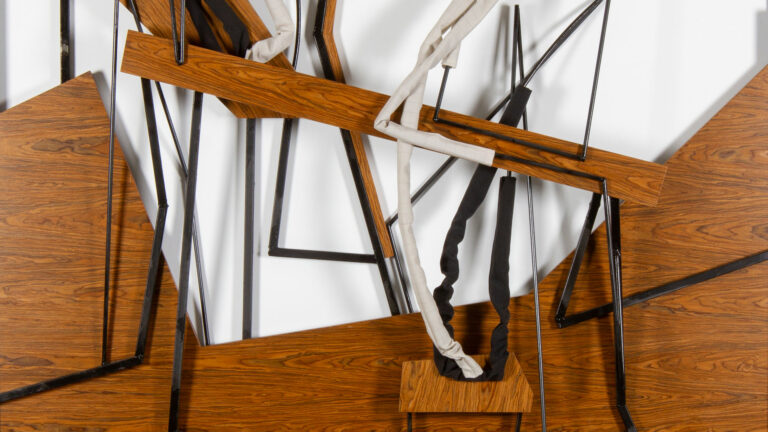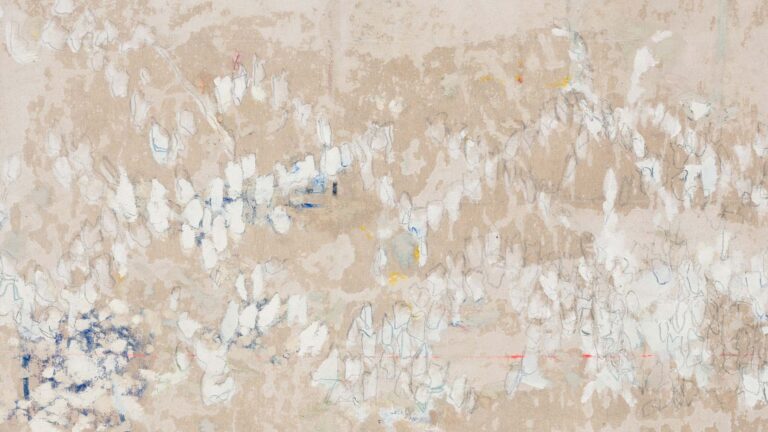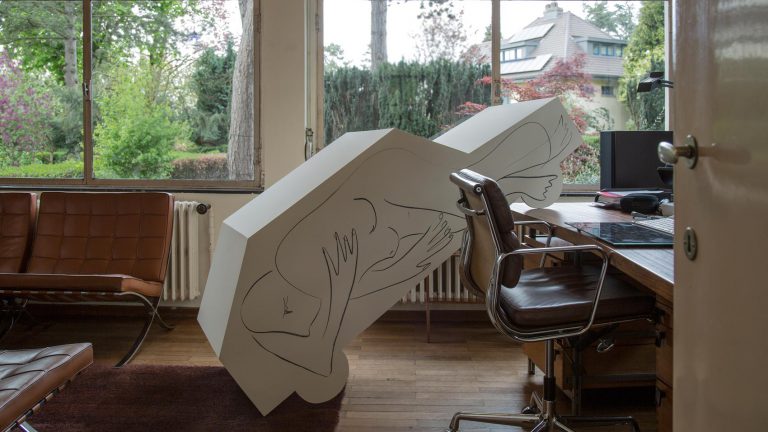Artist: Dodi Espinosa
Exhibition title: Casa de monos
Venue: trampoline, Antwerp, Belgium
Date: January 25 – March 17, 2018
Photography: Isabelle Arthuis, all images copyright and courtesy of the artist and trampoline
January 6, 2018 – Conversation between Dodi Espinosa, Daniela Apice and Simon Delobel
SD: Why did you wait so long before exhibiting your work?
DE: I wanted to be sure what I was doing, I think. My mother raised me to be a perfectionist. Maybe you could call it a lack of self-esteem. I think it was basically that I wanted to be strong enough to be confronted to the outside world. I met an artist who had been working her whole life without ever showing anything. She asked me to have a look at her work. Not long afterwards, she died. To me this was like a sign, telling me that I could not end up like her. I believe that if you have certain talents and do not use them, the energy starts to transform and acts against yourself. That is how I started the process, there was nothing else to do.
SD: Did the fact that you live in another country than the one you were raised in, or the time to adapt to a new context, play a role in the way you look at yourself?
DE: At the age of 16, I moved to the north of Spain, which was very conservative. I lived in a small town close to Santander which back then still had an equestrian statue of Franco on its main square. My family was one of the first immigrant families in that area. We were kind of excluded and experienced racism. This really influenced me a lot. Fighting to be part of a society you do not belong to. But it also pushed me to go further, I wanted to fight all these clichés, being Latin and with certain ideas of what that means. I wanted to break with all these ideas or expectations.
SD: How was coming to Belgium?
DE: It was not the same situation. Belgium was much more open but it was very hard in the beginning. I came just with one bag and slowly tried to find a way to survive. I found people to be much more open and receptive. So it was not that big of a deal adapting in Belgium. It was harder in Spain, which is hard to believe because you speak the same language.
SD: The language of the visual arts is universal. Unlike spoken words, do you think sculpture is able to bridge cultural differences?
DE: I do not know whether aesthetics is universal because society imposes what is. I think it has a lot to do with power. But unlike language or science, I do believe that art has a certain power. You cannot count or measure aesthetics: it touches our very own soul. Maybe I am a very romantic person. I cannot really define art, but to me it is a matter of the soul.
SD: When you create, do you have an ideal public in mind? How do you consider the viewer? It seems to me that you are more concerned by the material and the idea.
DE: The creative process always starts from a rather selfish starting point. This can be a trauma, an interest or something I am dealing with. At some point in the process, I try to connect it with the world out there, I try to render it universal because that is also a way to have contact. I never think about the viewer. Although I would love it if my work could reach kids. To me, one’s childhood is the most important period in a person’s life. That is when one’s personality is shaped.
SD: At trampoline you will show a selection of works from the last four years. How do you look back at these works?
DE: This may sound very selfish again, but in the works I mainly see a personal evolution. In order to continue creating, I had to clean up a lot of personal issues which I was carrying with me for so long. So the main evolution I see in the works, is my own evolution as an individual. I become more and more confident in what I am doing and in the way I interact with others. Through art, I was able to become a better person. I would like to develop my artistic work in a way to help others heal. In order to do that, I first have to be strong enough myself.
SD: Do I understand it correctly that you never react to a specific pre-existing art context?
DE: Freedom is very important to me: I really do not want to be classified. And I see myself as an entertainer, I want to surprise people and achieve something different. So in my case it is more a matter of reaching personal freedom.
SD: Through a kind of violence I must say, at least that is what I understand in your work.
DE: My past was violent. I come from Mexico where I lived a lot of moments of violence. When you grow up in an environment where you are not part of the ruling class, you end up living in a constant feeling of impotence. Because you cannot change things, you have to deal with them as they are. And that’s how you live in corrupt societies. You have to learn to live with the impotence. Maybe that is why violence and power are often subjects in my work. For a long time I had to deal with a lot of injustice. I used to have these utopic dreams of changing the world, making things better. It was not until I was in Cambodia, when I saw the war bas-reliefs of Angkor Wat with my own eyes that I experienced a strong yet beautiful representation of violence. Then I understood that I could not just erase evil like that. Trying to erase evil would be trying to erase and judge humankind as well. I had to accept that what we call evil was also part of ourselves.
SD: Violence and impotence, two elements I certainly see mirrored in the work Vox Populi…
DE: This work is once more related to my childhood. Bombardons were some of the instruments the locals used to play in the small town where my father was mayor. He was trying to change things, but at a certain moment we started receiving intimidating anonymous calls like “We want to kill you… Do you want to join or do you just leave?”. In the end my father was just forced to resign. I realized then that I could not really change things. Vox Populi was for me a way to talk about these matters, about the experience my father and my family lived.
SD: Religious references are also very present in your work. You use different pictorial elements that relate to preexisting stories, from the past cultures of Mexico to Christianity.
DE: That is the interesting thing about Mexico. The country is really a pastiche of all these cultural elements: it is Catholicism, it is the ruins of the precolonial civilization. Mexico possesses this double cultural moral of showing/not showing and has a very specific relation with sex, etc. You have all these different layers. Back in the time, before the Spanish domination, Mexico was not Mexico. It was a mix of many different tribes. It is really this mix of things that creates these chimeras which are part of my culture.
SD: A cosmopolitan culture in a way?
DE: I don’t know if you can call it cosmopolitan. I love the word syncretism. Normally this word has a negative connotation – at least when I read about it. But to me it is really exciting. Have you seen this documentary of Marina Abramović when she goes to Brazil? She is traveling because she is very obsessed with powerful places. She goes to a temple where you have all these mixes of symbols. You have very specific groups of people in Brazil who mix Egyptian beliefs with Hinduism, with precolonial things with Catholicism, etc…
SD: Could your work be considered as a reflection of globalism then?
DE: I am myself a reflection of globalism. As I told you already, I come from nowhere. It was a big issue for me, dealing with these matters of identity of not being Mexican, not being Belgian, not being Spanish either. I dealt with questions like ‘where am I from and what am I doing’. I met an artist once here in Belgium, she is from
Costa-Rica and half Dutch. She was talking about the same. Being a mix of something is difficult, especially if it is so contrasting; half European, half Latin, half esoteric and mystical, half pragmatic. But she gave me the advice to read the book La Frontera, the new Mestiza by Gloria Anzaldúa, that instead of seeing it as a nightmare you can see it as a talent. You have different connections, you understand different societies and groups better. I think it is actually a talent – to be able to read all these different layers.
DA: How do you render these personal issues, your life journey as to say, universal – and do you consider doing this at all?
DE: It will always be a personal journey, I know myself best. But we may not forget that we are all humans. By looking at certain things such as feelings and traumas, trying to understand the source of them, you can also reach the universal part of them. This is where my interest in art as a therapy comes from. I try to understand these universal matters and how something or an event can affect a person. Maybe I try to find universality by trying to read the inside. That is why in the work El Extasis the man is opening his belly. Visualizing what is at the core may seem a very individual point of view, but to me it is really the opposite. The man is trying to understand what we all have in common. That is why I gave it this title El Extasis. To me it is really about trying to establish the connection with the other. I try to understand the source of human feelings, how the human head works.
SD: Is it a kind of empathic art?
DE: I see my work as an empathic practice indeed, and I consider myself to be a very empathic person: I tend to carry the pain of the world and take things very personal. As a kid I was hypersensitive. I tried not to show emotions and to be a strong boy, while inside I was having these extreme feelings. Maybe that is why I made a lot of works dealing with masculinity.
SD: I get the feeling by looking at your works, that you really try to reach the viewer. To what extent do you try to trigger a physical reaction?
DE: That stems from a very personal point of view. The black paintings by Goya for example really captivated me because of its strength. I was also obsessed by the work of Frida Kahlo: the power in her work, the flesh. I try to achieve something similar, I try to get into the guts of a person. I know this can sound aggressive…
SD: You told me before that some of the works are more or less directly reactions to news events.
DE: I like to be confronted to things that people usually do not like to see. When I was a kid, I remember going to the hairdresser’s where I always read these popular Mexican magazines showing catastrophic events, like killings, accidents or car crashes. I secretly went through all these magazines because I wanted to feel how it would make me feel. I did not want to run away from it. The topic might be aggressive – and of course I am not enjoying the pain of others – but to me it is a challenge to look at those things. I like to put myself in a situation of discomfort. By digesting, I am able to translate it into something beautiful or even transform it through my work, you can call it a task that I have chosen.
SD: In your sculptures, you always start from scratch. You do not use found objects or appropriate images.
DE: With my work I want to trigger emotions. Keeping things in makes you sick. The Mexican attitude is one of affirmation and of acceptance. I guess I use art to take things a step further, saying I am not going to take it. I want to bring things out.
DA: Did you show the works in Mexico yet?
DE: No. But I will go there soon and I really want to show my works there. I do not know whether the reactions in Mexico would be different than in Belgium because to me it is going back to something I do not know anymore. I grew up in a small rural town and after the preparatory school I arrived in Europe. So I really do not know how Mexico is like, coming from a different environment. I use art in a way not to keep things inside. I do not just want to accept things. My father used politics to change things but it really did not work out for him. I have this idealistic believe that maybe through art you can do other things.
SD: In some of your works I feel strong references to other states of mind, to drugs or to something psychedelic. If art is a healing process for you, repairing from traumas, it seems that when you refer to all those psychedelic universes, it could also work as a form of escapism, finding another reality.
DE: I have this tendency to become very radical, it is in my genes. So it is a risk. I criticize Catholicism a lot, because it created a lot of pain for me. In art I have found my own religion, it is my way to escape from this existential situation where I cannot explain things at all. I am creating my own explanation of the universe. Of course that is a form of escapism, and yes there is something psychedelic in my work. Just have a look at what many ethnic groups create all around Mexico. Not so long ago I met a Mexican shaman here in Belgium during a workshop, and I am planning to see him again once I have visited Mexico.
SD: Would you consider your work to be surrealist? The way Surrealism defines art as a way to make a revolution or to the change the world?
DE: I always liked Surrealism a lot. One can consider the work of Frida Kahlo to be surrealist, but she did not consider it herself like that. Once, someone asked her about it and she answered ‘No, I paint my own reality’. Before I left Mexico my grandmother took me to the museum of modern art in Mexico city. I saw the painting of the two Fridas (Las dos Fridas, 1939). It is a double self-portrait, depicting two versions of Kahlo seated together. One is wearing a white European-style Victorian dress while the other is wearing a traditional Tehuana costume. Her husband Diego Rivera really loved the indigenous traditional Mexican Frida. Since Frida was half German, she also felt strongly European. So she portrayed the Tehuana Frida as the one who was adored by her husband while the European Frida is bleeding, rejected by him. So, to answer your question, I don’t know if I can consider myself a surrealist, I make my own reality.
SD: In your practice, you mainly express yourself with sculpture, not painting, at least, we do not see it in the exhibition. Is that because painting is less related to reality?
DE: Yes, I think so. I need to make things material, giving them a texture, so you can almost see them as equals. While painting is more a representation of something. When I try to express myself in painting or drawing, I have the feeling it is impossible. Somehow I think like a painter. In the work El Extasis I found a nice way to mix the two mediums. I really worked on it like a painting, thinking about formal issues like composition and proportion, but I made it in three dimensions. So maybe it is a way to find a compromise.
SD: Earlier in your studio we talked about your relation to archeological artifacts and the idea of fragments – finding objects without contexts.
DE: I told you earlier the story that we used to walk through the fields on Sunday around the archaeological site of Teotihuacan, finding broken pieces of pre-Hispanic items, which was a game in a way. In my head I was reconstructing stories, I was imagining who made the objects and why they made them. In the area where I used to live, Teotihuacan, you can still find plenty of things in the soil. A lot of people never communicate to the government when they build something because they can lose their houses. Once, I remember a small simple family calling my father that they were building a house and founded a tomb under the house. They wanted my father to come because they knew he liked these things. I went with him and took all the broken vases lying there. In my room I was gluing all these different vases back together, pretending to be an archeologist. Afterwards developed a big interest in archeology, in understanding the past, in reflecting the present in the past. For example in the work El Eterno Retorno, to be shown in a next exhibition, the footprints are incomplete. To me it is a way to invite the viewer to fill in the gap. I try to disturb my audience. I do not know if it works, but at least it is what I try to achieve.


